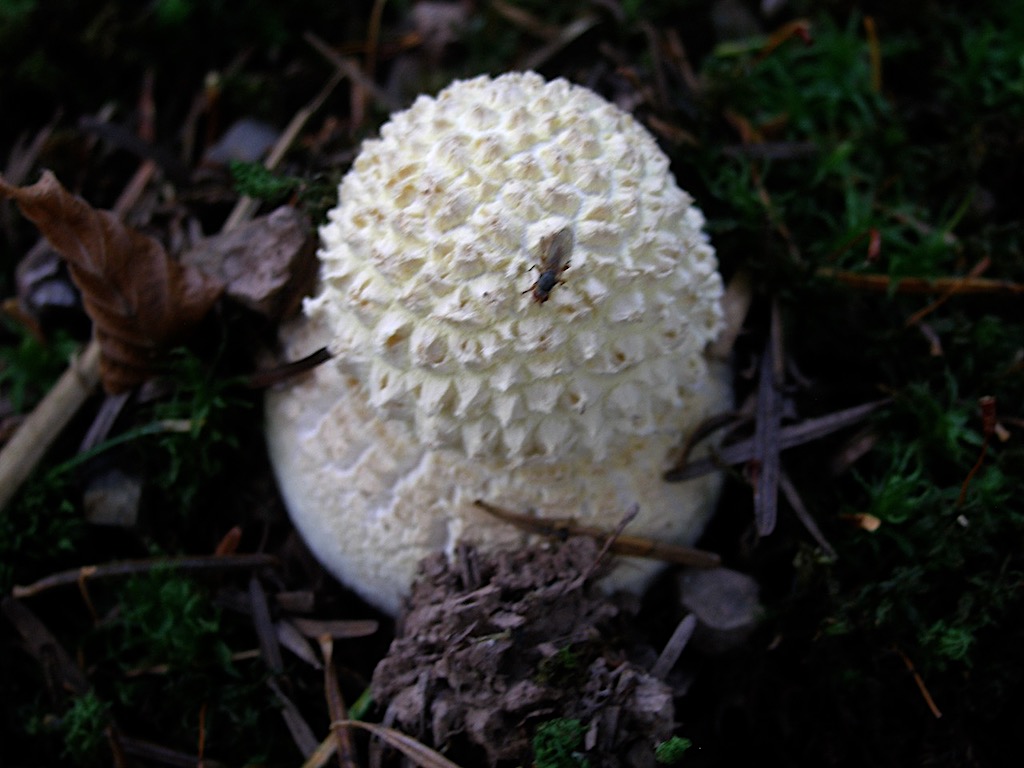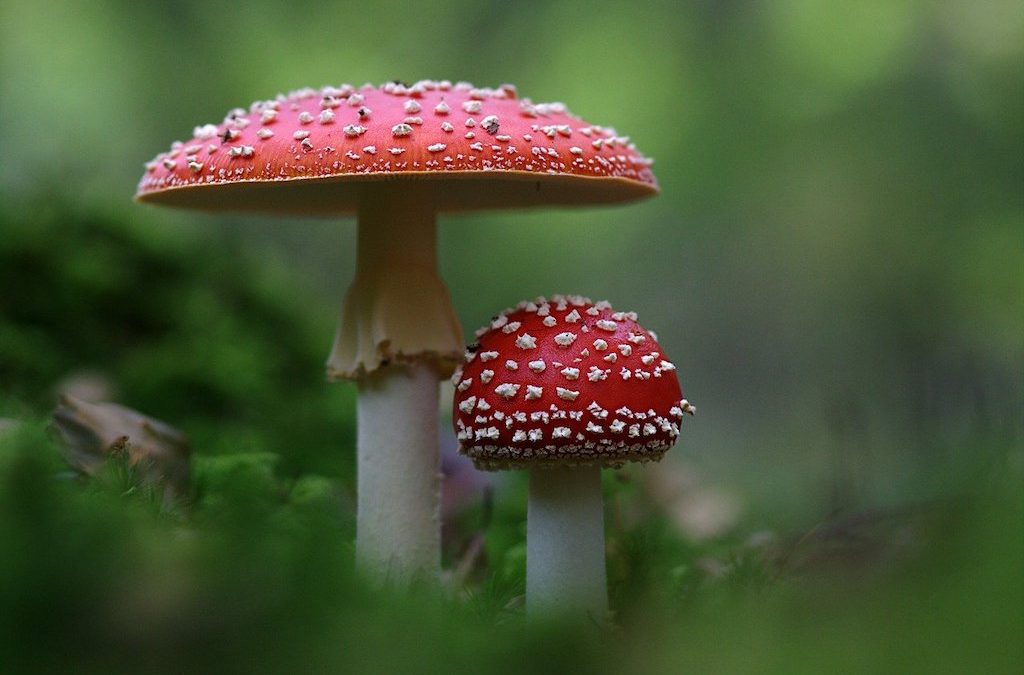
Fly Agaric (Amanita Muscaria)
Fly Agaric – a magical Mushroom
Bold and undeniably conspicuous, the bright red cap with its white flaky speckles gives this fungus away. Every child is familiar with the infamous ‘Fly Agaric’.
A familiar image in popular culture, it is known as the ‘Glückspilz’ (lucky mushroom) in Germany. It is one of the five quintessential symbols of good fortune, along with the pig, the 4-leaved clover, the chimney sweep, and horseshoes. Innumerable trinkets, variously cast in chocolate, marzipan, or plastic fill window displays, especially around New Year’s Eve.
Plaster-cast versions are also frequently found to decorate suburban lawns along with jolly old plaster-cast gnomes, smoking their plaster pipes. It is featured in innumerable children’s books illustrating innocent fairy tales. Like no other species, Fly Agaric symbolizes the magic of an enchanted forest with its magical groves. Everybody knows this is where fairies, gnomes, and witches dwell.
Fly Agaric in Mythology
Mythologies from around the world echo the enigma of the Fly Agaric. Everywhere it is seen as a semi-divine being and often it is associated with the mighty thunder gods and their cosmic fire. In India, for example, Fly Agaric is sacred to Agni, the god of fire. His devotees made sacrificial offerings of Fly Agaric while partaking of it as a sacrament. It is said to have helped them to commune with their god.
In Mayan dialects, Fly Agaric is known as ‘Kukulja’, which also means ‘thunder’. The Lacandon Maya call it ‘Eh kib lu’um’, which translates as ‘ the Light of the Earth‘ (Rätsch).
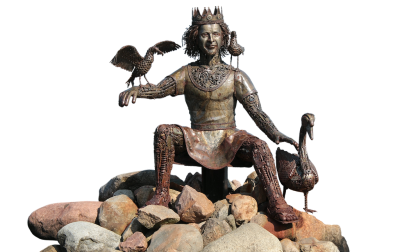 In parts of northern and Eastern Europe, it is sometimes called ‘Raven Bread’ in allusion to Woden’s companions. According to legend, the wise ravens were Woden’s constant companions. They would travel on his shoulders, whispering many a secret into his ears. Woden /Thor is a thunder-god. He is a wild, shamanic god of nature, who commands the elements. He gallops across the sky on his brave steed, Sleipnir, the eight-legged stallion, who runs swift as the wind and kicks up the storm clouds in his wake. As he gathers speed, foam forms at the horse’s mouth and drops to the earth. Magically, each drop of foam becomes a Fly Agaric.
In parts of northern and Eastern Europe, it is sometimes called ‘Raven Bread’ in allusion to Woden’s companions. According to legend, the wise ravens were Woden’s constant companions. They would travel on his shoulders, whispering many a secret into his ears. Woden /Thor is a thunder-god. He is a wild, shamanic god of nature, who commands the elements. He gallops across the sky on his brave steed, Sleipnir, the eight-legged stallion, who runs swift as the wind and kicks up the storm clouds in his wake. As he gathers speed, foam forms at the horse’s mouth and drops to the earth. Magically, each drop of foam becomes a Fly Agaric.
In Western mythology, the Fly Agaric represents the archetypal mushroom – even people who know nothing about fungi recognize it at once. But, depending on their heritage, people are mostly conditioned to fear all mushrooms (a condition known as ’mycophobia’). Only the flavorless varieties found on supermarket shelves are believed to be edible. (This has changed a bit, in recent years, as Eastern Europeans, who love mushrooms, have brought their love of fungi with them as they migrated around Europe.
Description
Fly Agaric (Amanita muscaria), is a gill-bearing toadstool, growing to between 5 -12cm tall. When young, it is covered by a white membranous veil, which rips as the stem pushes up and the bright red cap expands. The remains of the veil skirt the stem (ring) and also leave white, wart-like flakes on the cap.
(Caution: no white flecks is not a sure sign that whatever red-capped mushroom you may have found is NOT a Fly Agaric, since heavy rain can wash them off).
As the fungus matures the cap opens up like an umbrella, forming a depression around the center. Its red skin can easily be peeled off. The stem is bulbous at the base and discontinuous with the cap. The flesh is white and has no particular smell when fresh. Upon drying it develops an unpleasant musky-acrid smell, which, it has been claimed, can ward off flies.
This myth is supposed to explain the fungi’s name, but unfortunately, it is not true.
Related Species
In North America, A. americana, a closely related species can be mistaken for the Fly Agaric. However, its’ cap tends to be more yellowy-orange. Less similar and more toxic is A. pantherina, the Panther Cap. Its cap tends to be more yellow-brownish and its stem more slender. All of these Amanita species are generally considered poisonous and even deadly, and several other deadly poisonous Amanitas, such as the ‘Death Cap’, also join their ranks.
Is Fly Agaric poisonous?
In 2016, the American Association of Poison Control recorded some 6000 cases where ingestion has lead to some intense symptoms. But only four of these cases were fatal.
But that does not mean that they are ‘safe’, or don’t produce some serious symptoms.
Symptoms include: ‘nausea and vomiting, somnolence, dizziness, hallucinations, dysphoria, delirium, ataxia, myoclonic movements, and seizures.’ (American Association of Poison Control)
Yet, Fly Agaric features strongly in mythology and ritual use around the world – particularly in Asia.
Chemistry:
Mushroom guide books mark Fly Agarics with the familiar warning symbol of the skull and bones next to its name. Yet, despite this reputation, evidence from around the globe suggests that in the past (and, in some places even to the present day) people have actually enjoyed a rather intimate relationship with this ‘very dangerous’ mushroom. Apparently, this is no ordinary, poisonous toadstool, but rather a powerful psychotropic entheogen with a very colorful history and folklore.
Modern research has revealed that the chemical make-up of Amanita muscaria is rather complex. Earlier chemists had mistakenly assumed that the psychoactive principle of Fly Agaric was to be found in a tropane alkaloid known as muscarine. This substance, related to a group of alkaloids present in other ‘Witches Herbs’, such as Henbane and Belladonna, has a very unpleasant impact on the CNS, including profuse salivation, lachrymation, and perspiration. However, its concentration in the mushroom is actually very low (approx. 0.0003%). Furthermore, it does not easily cross the blood/brain barrier and nor does it have any psychotropic effect – thus it is hardly a likely candidate for the principle involved in producing the mushroom’s reputed mind-altering properties.
It wasn’t until the mid-sixties that the true entheogenic compounds of Amanita muscaria were positively identified as ibotenic acid and muscimol, its decarboxylated derivative. The research concluded that the actual psychotropic effect is most likely produced by muscimol (Chilton, 1975) since 50-100 mg of ibotenic acid produces the same effects as 10-15 mg of muscimol. The symptoms of inebriation are characterized by muscle twitching, dizziness, visual distortions (macropsia and micropsia), and altered auditory perception. (Chilton, 1975).
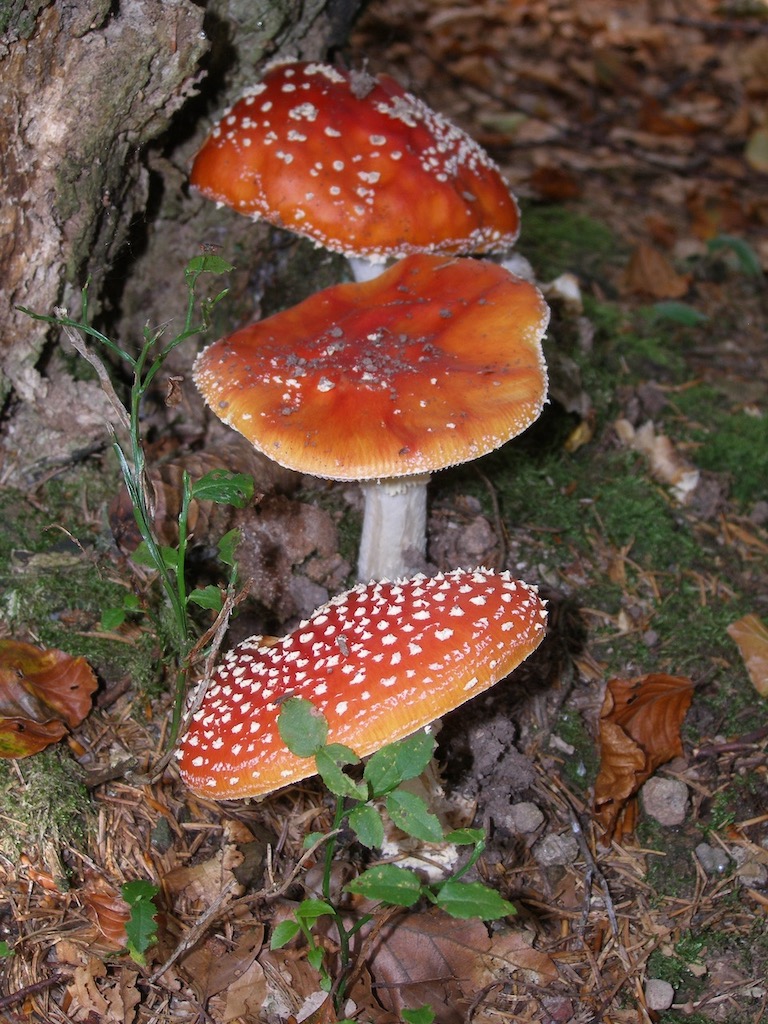
Ethnobotany of Fly Agaric
The potency of any particular mushroom is subject to various environmental factors, such as seasonal variation, the weather, the phase of the moon, and the pH level of the soil. The Kamchadals, the native people of Kamchatka (northern Siberia), have a long and well-documented history of Fly Agaric use. They believe, that Fly Agarics that desiccate while still connected to the earth tend to produce a stronger psychotropic effect than those that are picked fresh and strung up to dry. They also claim that the smaller ones, whose bright red caps are still covered with many white spots, are said to be stronger than the larger ones with paler caps and fewer spots. Those picked in August are said to be the strongest. It has been suggested that a dose of 9 – 10 caps could be considered potentially lethal, although no specific data supports this claim. The individual constitution, weight, and size of the person ingesting them would influence the result. Apart from the environmental and physical factors, the mental condition also plays an important role. Case studies have shown that people who mistakenly ingested the mushroom, believing that it was highly dangerous and that their lives were thus in peril, reported much more severe symptoms of poisoning than those who had intentionally partaken of it but misjudged the dose (Ott 1976a).
Archaeological and linguistic evidence traces Fly-Agaric use back to at least some 3000-6000 years BCE. Some scholars believe that it may stretch even further into pre-history and that it may be the most archaic entheogen known to mankind.
It appears that Fly-Agaric was known throughout Siberia but not universally used. Some tribes never used it, while others only consumed it ritually in a spiritual context, or used it medicinally, ritually, or simply for entertainment purposes. But the custom is best documented for northeastern Siberia, wherein some communities it persists to this day.
Mircea Eliade, the world’s foremost authority on Shamanism, described Fly Agaric ceremonies among the various Siberian tribes. However, colored by his own attitudes, he considered such practices (and for that matter any ceremonial use of psychotropic plants) as a decadent trend. (Eliade ‘Shamanism’ 1951) Many modern scholars disagree with his point of view, which sharply contrasts with the actual historical evidence (Rutledge). However, the casual use of Entheogens does seem to be a more modern development. Where this is practiced, the ritual use of Fly Agaric is gradually declining and is increasingly replaced by a more recent introduction: Vodka.
Fly Agaric Use in North-Eastern Siberia
However, Siberian shamans consider Fly Agaric the essence of their mysteries. It is their gateway to the experience of divine ecstasy, a trance-like state that enables them to fly into the world of their gods, battle with demons, and to gain fantastic visions. And it is this magical flight that the common name ‘Fly’- Agaric’ alludes to, not, as has often been suggested, its alleged power to ward off flies.
During the latter part of the 19th century, the German ethnologist J. Enderli spent 2 years among the Chukchee and Koryaks of Eastern Siberia. (Zwei Jahre bei den Tschuktschen und Korjaken). During his stay, he had the opportunity to witness first-hand one of these much-fabled, mushroom induced trance sessions. According to his report, the task of preparing the dried mushrooms fell to the women, who usually did not consume them themselves.
After selecting a few suitable specimens they began to chew them thoroughly so as to make them pliable and moist. They then took them out of their mouths, rolled them into sausage shapes, and gave them to the two men, who proceeded to place them deep down their throats to swallow them whole. After the fourth mushroom had been ingested in this manner the first effects began to show. The men started to tremble and twitch as though they had lost control of their muscles. Their eyes took on a wild glow, quite unlike the glazed look of alcohol inebriation, although the men apparently remained fully conscious throughout this phase.
The agitation increased until they suddenly fell into a trance-state and began to sing monotonously in low voices. Gradually their chanting became louder and wilder till they had worked themselves into a frenzy, their eyes glaring wildly, shouting incomprehensible words, and both of them going quite literally ‘berserk’. They demanded their (ritual) drums, which the women brought immediately. At once they began a wild, unbelievably frenetic dance accompanied by equally wild and ear-shattering drumming, yelling and singing, while both men ran about the yurt in a manic fury which left nothing untouched. Everything was thrown about, kicked over, and turned upside down until the place was in a state of total chaos. Eventually, almost as if struck dead, both of them collapsed exhausted and fell into a deep sleep.
This phase is the most important aspect of this exhausting ritual. It is in this trance-like sleep that the gateway to the ‘Other-World’ is opened, and the shaman experiences vivid, even lucid dreams and ecstatic visions, often of a strong sexual and sensual nature. In this state, he can diagnose the causes of diseases, determine the whereabouts of lost objects, retrieve lost souls, fight with demonic forces, or gleam visions of things to come. This otherworldly state, however, does not last long. After about half an hour of sleep, the shaman briefly awakes to full consciousness, but soon the inebriation sets in once more and continues in gradually weakening cycles of excitement, frenzy, exhaustion, and sleep.
The most curious aspect of this ritual is the fact that the inebriating power of the mushroom is not destroyed by normal metabolic processes but instead is passed into the urine almost without diminishing its effect. This has given cause to a rather unsavory habit described by some of the early ethnologists recounting their field experiences in Siberia:
‘Those who had partaken of the mushroom would collect their own urine and without a moment’s hesitation drink the liquid down, with the result of reinforcing the inebriation and starting the cycle all over once more. Sometimes the urine was saved in a special vessel for a later occasion or even shared with others who might not have been able to afford the mushrooms for themselves. (The rate of exchange in areas where it is not common is one reindeer per dried mushroom cap!) Even after passing through the body in this form substantial amounts of muscimol will again be passed into the urine unchanged. Thus it is said that the same mushroom can be ‘recycled’ 6-8 times.
Macropsia and Micropsia
During the phases of frenzy, the inebriated person feels tremendously strong. They are also affected by what is known as ‘macropsia’, or micropsia, a visual distortion that lets objects appear much larger or much smaller than they really are. Thus a blade of grass might seem as large as a tree trunk or a small hole can turn into the entrance of a cave. Many unbelievable feats of strength and endurance have been accomplished under the influence of Fly Agaric. One man reportedly carried a 120-pound load for 10 miles without stopping, something he could never have done under normal circumstances. Some historians have proposed that the notorious raids of the Vikings/Norse men may have been carried out under the influence, turning them literally into ‘Berserkers’ with inhuman strength. However, there is no concrete evidence to support this theory.
(It is interesting to note that Lewis Caroll in his classic tale, Alice in Wonderland, lets his heroine encounter the magic mushroom at the gateway between solid and lucid realities: It is the abode of the stoned caterpillar, who explains some of the oddities of Wonderland to the confused Alice. She had already experienced the wondrous effects of ‘macropsia’, and micropsia, which are typical symptoms of Fly Agaric inebriation.
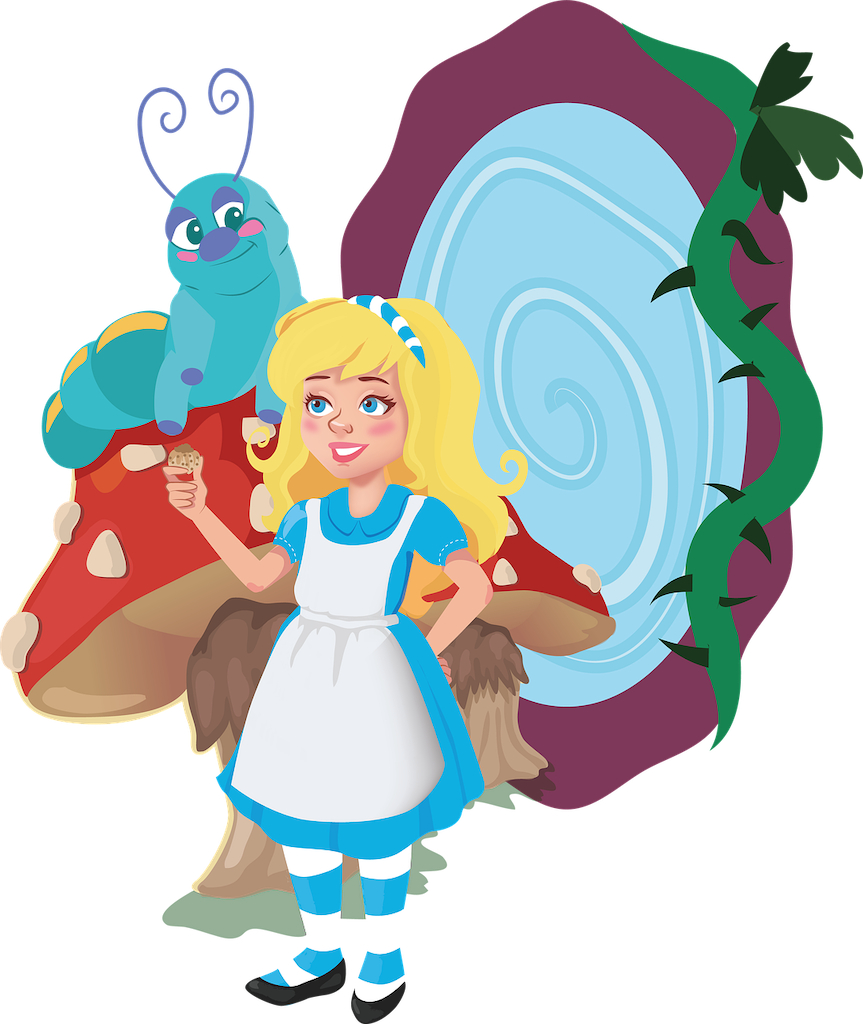
Other Methods of Preparation
The Koryak prepared the mushroom in several different ways. The most common one is described above.
Boiling:
They also occasionally boiled the fungi to make a mushroom soup. This method is said to reduce its potency. For an intoxicating effect more mushrooms would thus be needed.
Drying:
Sometimes dried mushrooms were soaked in distilled Bilberry juice – obviously a fairly modern method since distillation only reached Siberia in the 1500s.
Synergistic blending with Willow-Herb
Occasionally they were mixed with the juice of Willow-Herb.
To my knowledge, there has not been any research to investigate the possible synergistic action of this combination.
Medicinal use:
Medicinally, Fly Agaric was used for ‘psychophysical fatigue’ and for bites of venomous snakes. (Saar, 1991) It was also applied externally to treat joint ailments (Moskalenko, 1987). In Afghanistan, a smoking mixture containing Fly Agaric, known as tshashm baskon (‘eye opener’) is used for psychosis (Mochtar & Geerken, 1979). In Western medicine, Fly Agaric serves as a well-known homeopathic remedy, that is used for tic bites, epilepsy, and depression, and in conjunction with the homeopathic tincture of Mandrake, is used to treat Parkinson disease. (Villers & Thümen 1893, Waldschmidt 1992).
Fly Agaric Use in Western Cultures
Since the 1960s, the casual and experimental use of Fly Agaric in Western cultures has steadily increased. However, it is said that the effects of Amanita species found in North America and Central Europe are not equal to those found in Siberia. It is often claimed, (but not proven), that the North American and European species tend to be more nauseating and not as lucid as their Siberian cousins. It is unlikely that Fly Agaric will ever become popular as a recreational drug among casual thrill-seekers, as the inebriation is often accompanied by intense nausea and vomiting (some people have reported no other effect from their experiments).
While shamanic beliefs tend to regard vomiting as a way to cleanse the body of impurities, thus preparing it for possession by gods or spiritual beings, casual users tend to see vomiting merely as a rather unpleasant side-effect. Furthermore, Fly Agaric inebriation results in a severe hangover the following day, which also makes it a lot less appealing to casual users.
Those who have conducted self-experiments, often report visions of gnomes, not unlike those found in the suburban gardens mentioned above. These reports echo mushroom lore from Siberia, which features ‘mushroom-men’. They are depicted as small stocky, sometimes neckless beings, who move swiftly and guide the shaman on his journey to the ‘Other-World’.
This curious lore is substantiated by a number of Siberian cliff drawings that strongly resemble descriptions of these mushroom-men. The number of these little men that appear in the visions is said to correspond with the number of mushrooms consumed. The Yurak shamans always take 2 ½ mushrooms, who, they say, run ahead along convoluted paths. The shaman can only keep up with them because the ‘half-man’ runs more slowly.
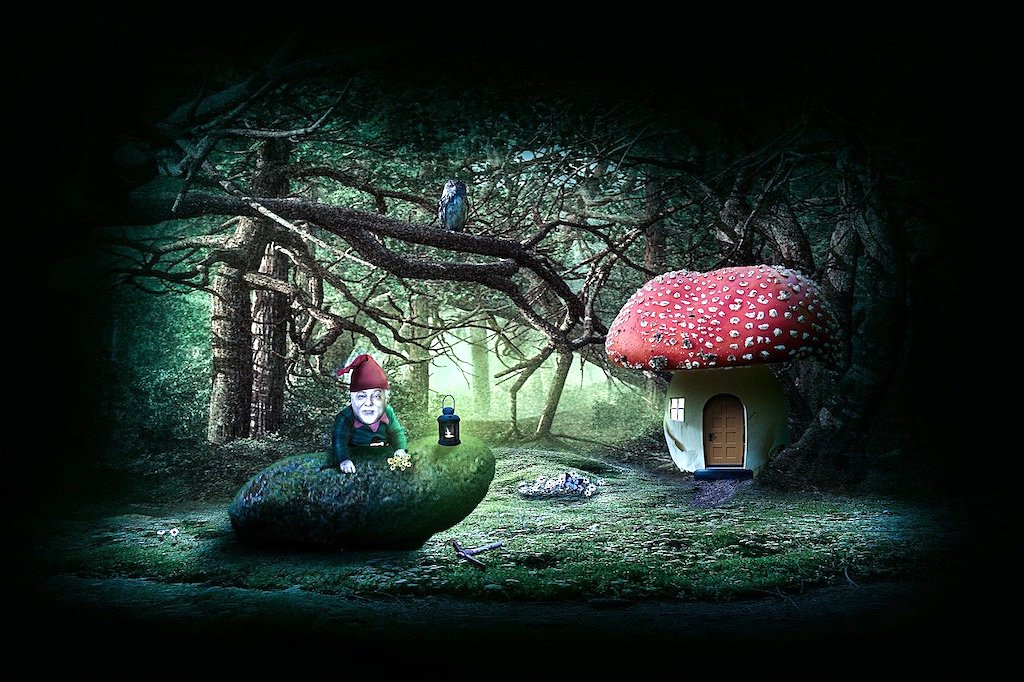
Gordon Wasson
It would be neglectful not to mention Gordon Wasson in any discussion of ethnomycology, as he and his wife have probably done more to stimulate research in this field than anybody else. In the course of their extensive research into the folklore and folk-uses of fungi, they came upon some very interesting findings, which lead them to believe that many of the mycophobic attitudes present today can be attributed to remnants of an ancient mushroom cult. According to their theory, subsequent layers of political and religious rulers have demonized the once ‘tabooed’ sacraments and holy icons of this cult (the mushrooms). Originally, they were deemed ‘taboo’ as their ritual use was considered a privilege of the ruling / religious class.
At the time, the academic establishment did not welcome such suggestions and point-blank rejected many of their findings. But, since they were amateurs with a passion for the fungi, rather than the world of Academia, they persisted. Eventually, their research did attract some attention and they began to collaborate with Albert Hoffman, who had discovered LSD. It is predominantly due to the Wasson’s pioneering work that the idea of psychotropic substance use (and in particular, psychotropic mushrooms) as an integral part of magico-religious practices among ‘primitive’ cultures has eventually gained widespread acceptance.
Wasson conducted extensive research into the ‘Rig Veda’, a collection of sacred hymns composed by the Indo-Aryan peoples, who swept down into the Indus valley of India some 3500 years ago. The ‘Rig Veda’ is one of the most ancient sacred texts known to humankind and it is full of references to sacred and medicinal plants. Many of them have been proven difficult to identify, however. One such plant or substance is known as ‘Soma’.
More than one hundred verses of the Rig Veda celebrate and sing its praises, describing its potent powers and alluding to its divine origin. Scholars today generally accept that Soma is probably some kind of psychotropic plant, although they still argue over its precise botanical identity.
Unfortunately, the authors of the ‘Rig Veda’ omit to mention any botanical details regarding its leaves, flowers, or fruit. Like most religious texts, the hymns are written in a rather poetic language, lacking a concrete description. Instead, it alludes to Soma as ‘the one-legged’, ‘thunder born’, and similar terms. Wasson concluded that this should be read as an allusion to its fungal nature. He proposed that Soma was in fact Fly Agaric. He argued that surely if the Soma plant did display ‘mighty roots’ or ‘sweetly smelling flowers’ or any other such noteworthy features, the authors of the ‘Rig Veda’ would no doubt have given them a poetic line or two. But mushrooms, of course, do not have such features, which would explain why there is no mention of them. The absence of such a description, he argues, in itself provides a strong hint.
Wasson studied the ‘Rig Veda’ in great detail and came up with a number of other supporting factors for his theory, which he published in his book ‘Soma’ in 1968. However, most of the scientific community at the time never quite accepted his proposals. Today, scholars are split into two camps, those who support Wasson’s’ findings, and those who are still doubtful and continue to search for an alternative explanation.
Certainly, it is challenging to translate and interpret ancient texts such as the Rig Veda, and be certain of its original meaning, beyond doubt. However, one has to ask the question of how and why such an obviously important substance could have been ‘lost’? The only plausible answer lends support to the Wasson camp: the Aryan people, who came from the north, brought with them only the cultural memory of this magical substance, but not the actual plant. It is impossible to cultivate Fly Agaric, and since it does not occur naturally in the Indus valley, it is likely that it gradually passed into the mythical realm. If one accepts the fungal nature of Soma, then Fly Agaric really emerges as the most logical choice, despite the fact that other psychotropic mushrooms are native to the homelands of the Indo-Aryan people. The use of these other species is not as widespread and common, and hardly anything is known about them, to this day.
However, the identity of Soma remains a mystery. Who really knows what people might have known and used in the distant past? Their knowledge has passed into oblivion. For all we know today, their sacred Soma – fungus or not, may even have long since become extinct.
WARNING:
Fly Agaric is a powerful fungus, whose effects can be extremely variable and dangerous in the hands of fools. Self-experimentation is not recommended. In particular, all amanita species with a white or greenish cap should be avoided, as these are definitely very deadly. The information provided in this article is intended for educational purposes only, and should not be taken as medical advice. The author takes no responsibility for any events that may occur as a result of self-experimentation.

